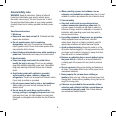
5
4. Power tool use and care
a. Do not force the power tool. Use the correct power tool
for your application. The correct power tool will do the job
better and safer at the rate for which it was designed.
b. Do not use the power tool if the switch does not turn
it on and off. Any power tool that cannot be controlled
with the switch is dangerous and must be repaired.
c. Disconnect the plug from the power source before
making any adjustments, changing accessories, or
storing power tools. Such preventive safety measures
reduce the risk of starting the power tool accidentally.
d. Store idle power tools out of the reach of children
and do not allow persons unfamiliar with the power
tool or these instructions to operate the power tool.
Power tools are dangerous in the hands of untrained
users.
e. Maintain power tools. Check for misalignment or
binding of moving parts, breakage of parts and
any other condition that may affect the power tools
operation. If damaged, have the power tool repaired
before use. Many accidents are caused by poorly
maintained power tools.
f. Keep cutting tools sharp and clean. Properly
maintained cutting tools with sharp cutting edges are less
likely to bind and are easier to control.
g. Use the power tool, accessories and tool bits etc.,
in accordance with these instructions and in the
manner intended for the particular type of power
tool, taking into account the working conditions and
the work to be performed. Use of the power tool for
operations different from those intended could result in a
hazardous situation.
5. Service
a. Have your power tool serviced by a qualified repair
person using only identical replacement parts. This
will ensure that the safety of the power tool is maintained.
Additional safety rules for edgers.
• Remove loose bracelets or similar jewellery from your
wrist whenever operating edgers or similar equipment.
• Before switching on always ensure that the blade and
guard function correctly and that they are free of any
damage. A cracked blade or guard must be replaced
before operating the tool.
• Do not use edger in the rain, or trim edges when they
are wet.
• The edger is a major appliance and should not be
operated with other major appliances on the same
household circuit.
• Keep extension cord clear of operator, unit and any
obstacles at all times. Do not expose the cord to heat, oil,
water, or sharp edges.
• Switch off and remove the plug from the ‘socket-outlet’ if
the flexible cord becomes entangled or before adjusting
or cleaning the edger.
• When making any adjustments to the tool always wait for
the blade to come to a complete stop and unplug the tool.
• Never attempt to unclog the blade chamber by tapping
the tool on the ground, this can damage the unit.
• Keep hands clear of edge guide and blade when cleaning
as these wear to a very sharp point during edging.
• Before landscaping or trenching, inspect and ensure
there are no exposed or buried cables or pipes or
other objects that may create a hazard or interfere with
operating the edger.
• Set depth to only that required for the job, do not
overload. If tool slows, pull back slightly and wait until
blade returns to normal speed.
• Never hang the edger by the power cord.
• Only use extension cords intended for outdoor use.














